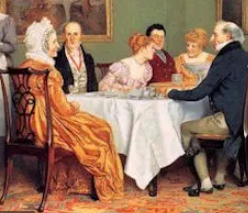Detachable, or false sleeves were common during the Regency era. They were basted to the armholes of a gown for easy removal. Before 1810, both the permanent and detachable sleeves were often made of similar fabrics. After 1810, however, they could be made from different materials. Two different kinds of removable sleeves were made: undersleeves and oversleeves.

Portrait of a lady by Henri François Mulard, ca. 1810 white dress, undersleeves, lace, blue and white sash and fichu, shawl, fawn gloves, coral beads, and hair comb.
This sumptuous painting of a lady wearing the most fashionable dress and accessories shows how the undersleeves add warmth to a gown that could best be described as thin and ethereal. The undersleeves are made of the same soft cotton as the overdress with its short, puffy sleeves.

Undersleeve, net, lace and mother-of-pearl, English, ca. 1810. Killerton House, National Trust Inventory nr. 1363159.2
These lacy undersleeves did not provide much warmth, but certainly added drama to a dress. I imagine they could be worn under a number of short sleeve garments.
This dress, made of red violet silk figured weave, had silk and cotton linings, silk piping, and was closed with a metal hook and eye. Museum of Fine Arts Boston.

This dress, ca. 1810 – ca. 1815, look like it has detachable sleeves made from the same fabric. Rijksmuseum.
The English ivory silk evening dress below has sheer, detachable oversleeves. Circa 1820. Kent State University Museum. While the undersleeves look more practical and serviceable, these oversleeves are breathtakingly gorgeous.
Regency ball gowns with net overlays became quite popular after 1810. The bodice detail of the 1820s evening gown below shows the exquisite sheer detachable oversleeve, which reveals the detailed puffed sleeve below.

Detail of the net oversleeve. It is a miracle that such good examples of these delicate gowns have survived. (Kent State Museum)
Also on this site:
- Regency fashion: The muslin and net period
- Sleeves, Georgian and Regency gowns












What a brilliant idea!
That portrait of a lady in the beginning of your post is stunning…I agree, this detachable sleeve idea seems like such a good one. Especially the lace overlays; very pretty.
Beautiful garments and detailed sleeves! I remember reading about the detachable sleeves somewhere else…what a great way to make clothing serve many purposes. Do you know, Vic, how they were attached? Buttons? Hooks and eyes? I’d be curious….
No buttons or hooks as far as anyone can tell. They were basted in place, as mentioned, or gathered under a band or garter. Modern seamstresses who make period clothes use an elastic band. I find this fascinating, for how does one prevent the over- or undersleeve from slipping or being ripped with exertion? Oh, I forgot, true ladies did not unduly exert themselves. Still, there must have been times…
I suspect the band’s holding power may have been reinforced by three or four stitches at strategic places… that could be readily cut away afterwards
Vic, I do not know if made up or not, but understand young ladies of landed gentry studied harpsichord while their male counterparts studied flute and violin. The reason: young ladies could not lift their arms up high enough given constraints of dress. There may be more of a backstory, but that is the one that has been passed down via oral history.
Peg, if that’s true it would explain a lot. I can see why they wouldn’t play cello – quite indecent – but one doesn’t read about young lady flautists or violinists. Great insight!
Love it – they just never moved very fast:)! Thanks for the answer. And the article!
However, did they not also play the harp? That does require one to keep arms raised and reach for the strings…..
But only in one plane of movement, and you don’t have to raise the arms too high, just on a level with your chest. the pictures of harpists of the time certainly show them with their upper arms held quite close to their bodies
Sarah, that is how they posed for portraits, but as a harpist myself, I can attest that it is a rather strenuous activity. We do make it look easy, but in fact, while you don’t raise your upper arms high (above your head), you do stretch considerably vertically, and that actually puts more stress on the armhole seams than any other place on the gown. And for a full glissando, you are also rocking back and stretching your back and shoulders to be able to pull through a run of the strings from the lowest to the highest.
Last spring I was asked to perform in costume at a tea and I could not play the harp in any of the regency or Civil War era garments I currently own. My sister, bless her heart, was able to give me a hand at the last minute. We took apart the top of one of my regency gowns and re-set the sleeves with a gusset in the sleeve extending along the bodice side seams to give me the range of movement I need. (One advantage of making your own gowns is that you have scraps leftover that you can use for these kinds of emergencies!)
As for playing the harp in a corset…. we won’t even go there. Let me just say that the two may coexist on a concert stage, but not on the same performer LOL. Perhaps that is why I see more portraits of young lasses (not of corset-wearing age) than those with more mature figures posing with harps.
wow, Cathy, thanks! that’s fascinating! it looks as though, then, harpists in the Regency had to have special dresses; of course as everyone made their own, this was something they could do, but that’s well worth knowing, I now need to find a way to use this in a plot [those plot bunnies always are ready to start] if someone is asked to play unexpectedly and doesn’t have her harp-playing gown with her… I’ve only ever played a lap harp so I don’t appreciate the exigencies of a fullscale one, my sister used to play but as she’s 12 years older than me and only played at school, I didn’t see much of it. I only recall being clipped round the ears for picking out 3 blind mice on her harp….
Fascinating, and how practical! and a good way of making over a garment easily since the style of sleeves changed with fashion more than the basic shape of the gown.
Ethereal sheer sleeves. So feminine and alluring.
Patty, you can see a variety of undersleeves at this link to the Museum of Fine Arts, Boston. http://tinyurl.com/ymswc9. This tradition continued well into the mid 19th century.
I love the gowns from the Regency era – they are so feminine, and I love the detachable sleeves. Wish we had those now – my upper arms are no longer fit for viewing.
Fascinating. Thanks, Vic.
Wow, it is amazing these beautiful dresses and sleeve attachments are in such good shape after more than 200 years. The ivory silk evening gown looks like it could be worn today – such lovely material and color.
I’m watching one of the series about Napoleon and of course, all the female characters are wearing the empire waist dresses and, many look as if they have the detachable sleeves.
Thanks Vic, for taking us away to that magical time via the dresses and special sleeves.
PS The portrait of a lady by Henri François Mulard, reminds me of Jane’s famous Elizabeth Bennett!
On a practical note – if you make period dresses for English Country Dances, JASNA AGM, etc., you can make a long sleeve for daywear and remove it for the ball in the evening. the gown has the short puffed sleeves, and the long sleeve is basted in at the bottom of the puffed sleeve for a day look.
Beautiful! And once again, Vic, you have added to my education. I could make quite a list of things I wouldn’t know if I hadn’t discovered your blog!
I second Jean’s comment. Thanks for your fascinating posts of Regency-era life. Lovely examples.
I’m currently designing a ball gown for myself a mature lady with “bingo wings” so am looking at sleeves generally. I am definitely going to add a voile detachable long sleeve. I hadn’ t thought about oversleeves so that is something else to consider. Many thanks.
Biscuits…. I tried to message you but couldn’t figure out how. Wasn’t sure it was okay to post an email address here. I’ve made one complete set and I started a second set made a totally different way. I was going to write and tell you how I made them as it’s really quite simple if you use the correct net. Since they are done totally by hand, it’s more time consuming than anything. I hope you can find a way to send a private message to me. Not sure the entire list wants my detailed explanation of how to do this, although I am willing to share. ;)
Cathy, if Vic is willing for you to guest blog I, for one, would be fascinated [and I shouldn’t mind you guest blogging for me too!]